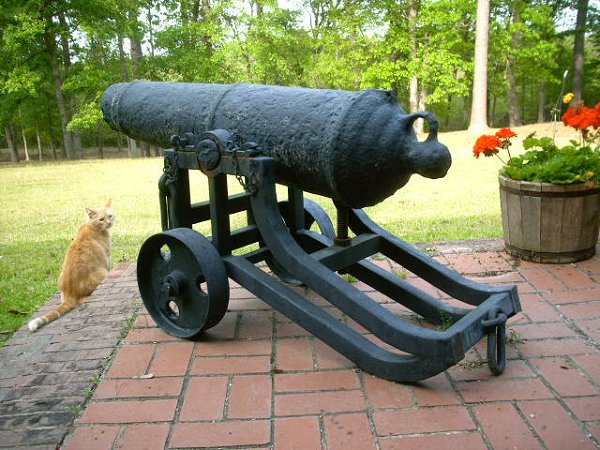
Carronade Naval Gun
by CW2 Ralph Lovett
This muzzle loading smoothbore style weapon was first produced by the Carron Company in Falkirk, Scotland. The Carron Company, at first had problems with the quality of their cast iron and set out to improve the quality of their cannon in general. Among these steps of improvement was the introduction of solid cast cannon then drilled out with a boring mill. Two improvements came with this new method. First, the solid cast gun was less likely to have imperfections that could later cause the piece to rupture on firing. Second, the milling operation gave a more perfect sizing of the gun bore than had been possible with guns cast around a central pole or “newel”. This meant that not only were the newly produced pieces more reliable and safe but also more efficient. This was because these guns had much less “blow by” due to “windage”. “Windage” is the gap between the projectile and the interior of the gun bore. When this gap was greater, the “blow by” was excessive and the gun lost power and range as a result. Other important characteristics seen in Carronades are short barrel length resulting in reduced weight and lower velocity. Both these meant shorter range but with lower velocity the projectile fired from the Carronade actually did more damage. This may seem counterintuitive but the faster moving projectile tends to make a clean hole punched through a ships side, where as, the lower velocity piece tends to break up and splinter its target. This is the reason for one of the Carronade’s many nick names the “Smasher”. Carronades found their way not only into the British Navy but were used world wide in the 1800s. The Imperial Russians used them in their California outpost of Fort Ross and the Ottoman Navy had Carronades cast with their distinctive crescent moon and star symbol on the face of the tube. The Carronade also became one of the most common pieces found onboard merchant ships in the 1800s. Because the Carronade was comparatively light it could be moved from gun port to gun port. On a ship that mainly existed to carry the weight a goods not cannon this meant an economy. The few Carronades on the deck could be moved to the side of the ship threatened. Also, with the impressive destructive effects of the Carronade at short ranges a merchant crew, not likely as well drilled in gunnery, could still have a great effect on an attacker. With these defensive weapons onboard, the shipping insurance company, “Lloyds of London” gave a better rate. This is how the Carronade got anther of its nick names the “Lloyds Gun”. Generally, Carronades were cast with a pivot mount on the underside of the tube. Later the Carronade was produced with tunnions, as with conventional guns. The Carronade in the Lovett Collection is one of these later types with conventional trunnions. These Carronades are often referred to as Gunnades. The Carronade in the Lovett Collection was one of the earliest pieces acquired in the mid 1980s. It is mounted on a reproduction British Iron Garrison Carriage. These often were used in garrisons because unlike the wooden carriage the iron did not deteriorate in the weather. We display our Carronade outdoors so for us the Garrison Carriage is also a good solution.